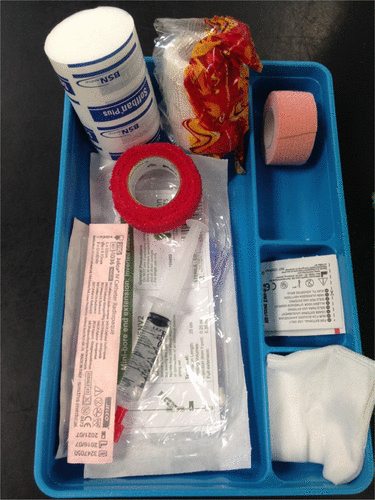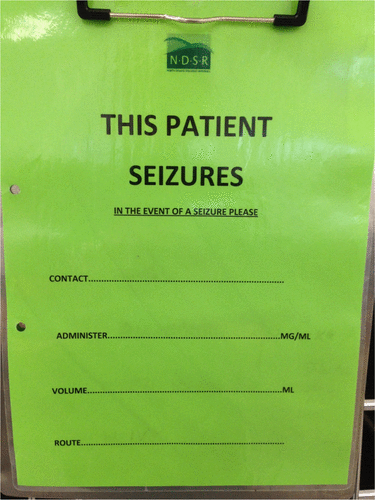Abstract
This article introduces different types of seizures in both canine and feline patients. The aetiology of seizures and the diagnostic work up involved in creating a differential diagnostic list for the neurologist will be discussed. Emergency treatment veterinary nurses can provide for those patients presenting in status epilepticus will be highlighted. Short-term and long-term antiepileptic drug treatment will be reviewed including the side effects of the medication. The quality of life for seizure patients will also be analysed drawing from research and the role the owner plays in ensuring their pet retains a good quality of life.
What is a seizure?
A seizure is an involuntary change in behaviour or neurological status due to the abnormal activity of central nervous system (CNS) neurons (Lowrie, Citation2013). Neurons are excitable cells of the CNS that process and transmit information through electrical and chemical neurotransmitters; an imbalance in excitatory and inhibitory signals is what causes a seizure.
Seizures can be classified into two types, focal and generalised. It is possible for focal seizures to progress to generalised seizures (Lowrie, Citation2013).
Focal seizures
These are also known as partial seizures. They affect one hemisphere of the brain (Berendt et al., Citation2015) and therefore motor manifestations are asymmetric. Simple focal seizures include facial twitching and there is thought to be no impairment of consciousness; however, with complex focal seizures there seems to be an impairment of consciousness. Clinical signs in dogs include fly catching, tail chasing, aggression, running in circles and vocalisation. In cats drooling, excessive vocalisation and rapid running inside the house are some of the clinical signs displayed (Podell, Citation2013). These seizures are believed to originate from the limbic system and create hallucinations.
Generalised seizures
The seizure activity starts in one hemisphere and spreads to both cerebral hemispheres; therefore, motor manifestations are bilateral (Berendt et al., Citation2015). There is an altered consciousness and the animal is unaware of its surroundings (Lowrie, Citation2013). Autonomic signs such as urination, defecation and salivation are portrayed with this type of seizure (Lowrie, Citation2013).
Generalised seizures include cluster seizures; when an animal has more than three convulsive seizures in 24 h (Platt & Olby, Citation2013) or status epilepticus; when an animal has two or more seizures without recovering or one seizure lasting more than 5 min (Podell, Citation2013). In dogs, generalised seizures are the most common type. Patients displaying status epilepticus require immediate emergency treatment as they can cause permanent brain damage and even death (Platt & Olby, Citation2013).
Aetiology
Seizures originate from the forebrain and the physical manifestation depends on the location of the abnormality (Lowrie, Citation2013). There are multiple reasons why a dog or cat seizures and they can be classified as intracranial or extracranial in origin. Intracranial causes are when the primary disease is located within the brain. Lesions causing seizures can be as a result of any of the following: vascular, inflammatory, infectious, toxic or traumatic, congenital anomaly, metabolic, idiopathic, neoplastic or degenerative. The cerebrum is vital in normal behaviour and alertness, vision and interpreting conscious sensory stimuli. Lesions of the cerebrum may therefore portray any of the following: altered behaviour, central blindness, decreased levels of consciousness and circling.
Extracranial causes of seizures are metabolic such as toxin ingestion, electrolyte imbalances such as hypocalcaemia, hypoglycaemia more commonly in kittens and puppies or diabetic patients, hepatic encephalopathy (Bagley & Platt, Citation2013) or thiamine deficiency in cats due to an incorrect diet (Muñana, Citation2013).
Epilepsy
Epilepsy is a neurological syndrome characterised by recurrent seizures (Thomas, Citation2010) and can be categorised into two types: primary (idiopathic) where there is no structural brain lesion and secondary where there is an identifiable structural lesion (Berendt et al., Citation2015). Idiopathic epilepsy is one of the most common chronic neurological conditions seen in companion animals and humans (Chandler, Citation2006).
Diagnosis
A full clinical history from the owner is an essential component in finding out if the patient is seizuring and why. Patient signalment (species, breed, age, sex and bodyweight), seizure history (for example, when do they seizure: following exercise, postprandial (Vite and Long, Citation2007) or during sleep?). Asking what the animal looked like before and after the seizure is also an essential question (Vite and Long, Citation2007). Information such as potential toxin ingestion, recent traumatic incidents, current medical conditions and medications, behavioural changes, physiological changes such as weakness, lethargy, polyuria, polydipsia, altered mentation, weight loss, vomiting or diarrhoea. Obtaining this information will help greatly with treatment choices at initial presentation and future treatment for that patient (Bloor, Citation2013). Home videos of the presumed seizure activity are also extremely helpful for a neurologist when compiling a differential diagnosis list (Vite & Long, Citation2007). There are numerous non-epileptic paroxysmal disorders that can mimic the clinical signs of a seizure and are therefore not responsive to antiepileptic drugs (AEDs) (Lowrie, Citation2013), hence videos can be an essential component in diagnosing a patient correctly.
Questioning the owner about potential toxin ingestion can be life-saving to a patient. Metaldehyde poisoning from snail and slug bait and ethylene glycol poisoning from ingestion of antifreeze are some examples. In the author’s experience of toxins causing seizure activity, it has been from the oral ingestion of spot-on flea and worming products such as ivermectin or moxidectin. Moxidectin is used in veterinary medicine for heartworm prophylaxis and large animal endoparasitism (Crandell & Weinberg, Citation2009). Incorrect administration of antiparasitic spot-on treatment Advocate® (Bayer) can cause seizures if ingested orally (See et al., Citation2009).
Blood tests such as a biochemistry profile and electrolytes are also essential on presentation to quickly rule out metabolic causes of seizures such as hypoglycaemia or hypocalcaemia. Advanced diagnostics include magnetic resonance imaging (MRI); this would be necessary if no anomalies were found in the blood work up, or there was no toxin ingestion. This may be indicative of something more severe, for example neoplasia (lymphoma or a meningioma), a vascular attack such as a cerebral infarct, inflammatory disease such as necrotising meningoencephalitis (NME) or an infectious disease such as distemper or infectious encephalitis.
A cerebrospinal fluid tap (CSF) is recommended in patients with neurological deficits or if lesions are seen on MRI (Podell, Citation2013). Infectious diseases such as neosporosis and toxoplasmosis that may be the cause of the seizure activity (Muñana, Citation2013) can be diagnosed from a polymerase chain reaction (PCR) test on the spinal fluid.
Emergency treatment
Systemic stabilisation after a seizure starts by referring back to basic medical emergency measures; airway, breathing and circulation (ABC) (Platt & Olby, Citation2013). Veterinary nurses (VNs) can perform triage and aid the patient back to a stable condition for treatment to be initiated and any diagnostic tests required to be performed.
Airway
Checking for a patient airway is paramount (Lowrie, Citation2013). Salivation is an autonomic sign presented during both focal and generalised seizures and may require assistance clearing their mouth. Patients may also bleed from biting their tongue during a seizure.
Breathing
Patients require oxygen to ensure optimal tissue perfusion; the method of oxygen delivery should be decided based on that individual patient’s status and also what would cause the least stress (Bloor, Citation2013). If the patient is conscious flow by oxygen or a mask would be preferable and if the patient is unconscious intubation and mechanical ventilation may be warranted (Lowrie, Citation2013).
Circulation
Does the patient have intravenous access, require intravenous fluid therapy (IVFT) or blood pressure monitoring? Intravenous access must be obtained as soon as possible to allow for AEDs to be administered should another seizure occur and also for the delivery of IVFT (Lowrie, Citation2013). Obtaining IV access in a moving patient can be challenging so rectal diazepam should be at hand to help immobilise the patient with the aim to reduce the seizure activity as well (Bloor, Citation2013). Regular blood pressure monitoring will indicate if adequate IVFT is being administered to ensure cerebral blood flow is being maintained (Lowrie, Citation2013).
Core body temperature monitoring of the patient should be measured. Seizuring patients will often present hyperthermic due to increased muscle activity, slow passive cooling methods must be initiated if body temperature is above 40°C (Lowrie, Citation2013). Non-invasive cooling methods include administering cool IVFT, ice packs wrapped in towels around the patient, surgical spirit on foot pads and fans in front of the kennel can all aid with reducing temperature, but close monitoring of the patients temperature should be adhered to in order to prevent rebound hypothermia (Bloor, Citation2013). Brain damage following seizures may affect the thermoregulatory centres in the brain, also resulting in hypothermia in these patients (Bloor, Citation2013).
Blood sampling may be required to monitor blood glucose, electrolytes or acid base status and for those patients already on AEDs, blood samples for therapeutic monitoring should be obtained (Platt & Olby, Citation2013).
Long-term treatment
The main aims of antiepileptic treatment are to improve the quality of life for the patient by reducing the frequency, duration, severity, post-ictal phase and the total number of seizures over a short period of time (Potschka, Citation2015). In the human field, the World Health Organisation has stated that quality of life is an important aspect in treating idiopathic epilepsy in humans. Assessing quality of life in companion animals is much harder and therefore the owner must assess this on their behalf. The quality of life for the owner must also be considered as they are caring for their pet who suffers from seizures which can be very distressing to witness. There are minimal studies on the impact of seizures and how the quality of life for dogs is affected (Wessman et al., Citation2016). One study has aimed to demonstrate a dog’s quality of life compared with seizure frequency and side effects of AEDs from owners’ perspectives. Chang, Mellor and Anderson (Citation2006) found that a frequency of less than one seizure every 3 months is considered adequate seizure control and therefore a good quality of life for their dog.
Repeated epileptic seizures result in numerous negative effects on the brain including neuronal death, disturbance of the blood–brain barrier function and persistent inflammation which contributes to the duration and recurrence of seizures (Librizzi et al., Citation2012). The brain pathologies can cause significant transient or permanent neurological impairment (Lowrie, Citation2013) leading to behavioural changes in that animal often exacerbating current clinical signs which are affecting the quality of life for that patient.
Owner education and ultimately compliance is paramount to ensure AED treatment is effective. The importance of timings of medications, not missing or suddenly stopping treatment is crucial. The owner should discuss with the veterinary surgeon or neurologist suitable times for them to medicate their pet and adhere to these times long-term. This proves more difficult with feline patients who require AEDs, especially with outdoor cats who may miss medication times or if the owner is unable to medicate, which can even be a challenge for veterinary staff with hospitalised cats.
Educating owners of the side effects of AEDs and any therapeutic monitoring involved is also a necessity. AEDs such as phenobarbitone (Epiphen, Martindale) and potassium bromide (Epilease, Dechra) require regular blood tests once treatment is initiated. This is to measure the concentration of AED in the blood to assess whether the same or a higher dose needs to be administered depending on how well the seizures are being controlled.
Last but not least, there is the financial aspect. Most patients requiring AEDs will be on them long-term if they have primary epilepsy. Owners without pet insurance will find this treatment quite costly.
Side effects of AEDs
There are always going to be side effects from drugs and with AEDs this is sometimes the deciding factor as to whether the dose can be increased to improve seizure control. In the author’s experience often the side effects can be worse than the seizures, especially for the first few days of initiating treatment. The most common side effects of phenobarbitone (Epiphen, Martindale) are polydipsia, polyuria, polyphagia, ataxia, sedation (Lowrie, Citation2013). The author has seen severe sedation effects from phenobarbitone causing a patient to be non-ambulatory for a number of days.
The organs affected during metabolising AEDs must also be taken into consideration. Phenobarbitone can cause hepatotoxicity if not administered correctly following the recommended doses (Dewey, Citation2006). The author has seen evidence of this from using toxic doses of phenobarbitone over a long period of time.
Levetiracetam (Keppra, Aesica) can be considered in those patients with liver disease as 90% is renally excreted (Lowrie, Citation2013). Volk et al. (Citation2008) found that the only side effect reported from levetiracetam was sedation in 3 of 22 dogs. The author’s experience of nursing patients on this drug has been very positive and a rapid seizure reduction has been evident.
Potassium bromide (Epilease, Dechra) could predispose dogs to pancreatitis. A study investigating the use of levetiracetam (Keppra, Aesica) in dogs which were pharmacoresistant to phenobarbitone (Epiphen, Martindale) and potassium bromide (Epilease, Dechra) demonstrated this; the dog had to stop receiving potassium bromide before the study due to developing severe pancreatitis (Volk et al., Citation2008).
Conclusion
As discussed, epilepsy is a common neurological condition but is often misdiagnosed for paroxysmal disorders including movement disorders such as episodic falling in the Cavalier King Charles Spaniel or myokymia, vestibular attacks, syncope or more recently canine epileptoid cramping syndrome (Lowrie, Citation2013). The importance of obtaining a detailed clinical history and appropriate blood tests to ensure a more accurate differential diagnosis list cannot be emphasised enough, to avoid an incorrect interpretation of the behaviour portrayed by the patient.
The prognosis for seizure patients depends on the individual patient, the aetiology of the seizures and the time taken to diagnose and treat appropriately (Bloor, Citation2013). Veterinary professionals strive to treat seizures appropriately, but the quality of life of the patient must be taken into consideration, not just when treatment is initiated but throughout its life. It is important to remember that AEDs do not modify the disease, they control the clinical signs.
Additional information
Notes on contributors

Daniella Sines
Daniella Sines qualified as a registered veterinary nurse in 2009 from the Royal Veterinary College after completing a BSc(Hons) degree in veterinary nursing. She started working at North Downs Specialist Referrals in Surrey that same year to the present day and is now working there as a neurology nurse. Daniella completed the graduate diploma in professional and clinical veterinary nursing from the Royal Veterinary College in 2015.
References
- Bagley, R. S., & Platt, S. (2013). Coma, stupor and mentation change. In S. Platt & N. Olby (Eds.), BSAVA manual of canine and feline neurology (Ch. 9). BSAVA: Gloucester.
- Berendt, M., Farquhar, R. G., Mandiger, P. J. J., Pakozdy, A., Bhatti, S. F. M., De Risio, L., … Volk, H. A. (2015). International veterinary epilepsy task force consensus report on epilepsy definition, classification and terminology in companion animals. BMC veterinary research.
- Bloor, C. (2013). How to manage seizures. The Veterinary Nurse, 4(1), 40–46.10.12968/vetn.2013.4.1.40
- Chandler, K. (2006). Canine epilepsy: What can we learn from human seizure disorders? The Veterinary Journal, 172, 207–217.10.1016/j.tvjl.2005.07.001
- Chang, Y., Mellor, D. J., & Anderson, T. J. (2006). Idiopathic epilepsy in dogs: Owners’ perspectives on management with phenobarbitone and/or potassium bromide. Journal of Small Animal Practice, 47(10), 574–581.10.1111/jsap.2006.47.issue-10
- Crandell, D. E., & Weinberg, G. L. (2009). Moxidectin toxicosis in a puppy successfully treated with intravenous lipids. Journal of Veterinary Emergency and Critical Care, 19(2), 181–186.10.1111/vec.2009.19.issue-2
- Dewey, C. W. (2006). Anticonvulsant therapy in dogs and cats. Veterinary Clinics of North America: Small Animal Practice, 36, 1107–1127.10.1016/j.cvsm.2006.05.005
- Librizzi, L., Noè, F., Vezzani, A., de Curtis, M., & Ravizza, T. (2012). Seizure-induced brain-borne inflammation sustains seizure recurrence and blood–brain barrier damage. Annals of Neurology, 72(1), 82–90.10.1002/ana.23567
- Lowrie, M. (2013). Companion Animal, 18(5), 198–204.10.12968/coan.2013.18.5.198
- Muñana, K. R. (2013). Head tilt and nystagmus. In S. Platt & N. Olby (Eds.), BSAVA manual of canine and feline neurology (Ch. 11). Gloucester: BSAVA. .
- Platt, S., & Olby, N. (2013). Neurological emergencies. In S. Platt & N. Olby (Eds.), BSAVA manual of canine and feline neurology (Ch. 20). Gloucester: BSAVA.
- Podell, M. (2013). Seizures. In. S. Platt & N. Olby (Eds.), BSAVA manual of canine and feline neurology (Ch. 8). Gloucester: BSAVA.
- Potschka, H. (2015). International veterinary epilepsy task force consensus proposal: Outcome of therapeutic interventions in canine and feline epilepsy. BMC Veterinary Research.
- See, A. M., McGill, S. E., Raisis, A. L., & Swindells, K. L. (2009). Toxicity in three dogs from accidental oral administration of a topical endectocide containing moxidectin and imidacloprid. Australian Veterinary Journal, 87(8), 334–337.10.1111/avj.2009.87.issue-8
- Thomas, W. B. (2010). Idiopathic epilepsy in dogs and cats. Veterinary Clinics: Small Animal Practice, 40(1), 161–179.
- Vite, G. H., & Long, S. N. (2007). Neurological emergencies. In L. G. King & A. Boag (Eds.), BSAVA manual of canine and feline emergency and critical care (2nd edition, Ch. 9). Gloucester: BSAVA.
- Volk, H. A., Matiasek, L. A., Luján Feliu-Pascual, A., Platt, S. R., & Chandler, K. E. (2008). The efficacy and tolerability of levetiracetam in pharmacoresistant epileptic dogs. The Veterinary Journal, 176, 310–319.10.1016/j.tvjl.2007.03.002
- Weesman, A., Volk, H. A., Packer, R. M. A., Ortega, M., & Anderson, T. J. (2016). Quality-of-life aspects in idiopathic epilepsy in dogs. Veterinary Record, 179(9), 229.


